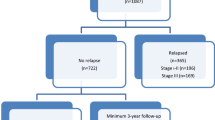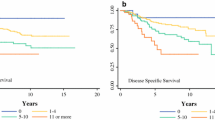Abstract
Background
Tumor mitotic rate (MRP) is an independent prognostic factor in clinically localized primary cutaneous melanoma, but the prognostic importance of mitotic rate in melanoma recurrences (MRR) is not known. In this study, we sought to determine the prognostic value of MRR and other clinicopathologic factors in recurrent melanoma.
Methods
Patients with primary cutaneous melanoma diagnosed between 1979 and 2006, who subsequently developed recurrence(s), were studied. Histologic sections of primary and first locoregional recurrences of melanoma were examined, and MRP and MRR were measured. Relationships between MRR, known prognostic parameters in melanoma, time to first recurrence (TTR), and postrecurrence survival were analyzed.
Results
A total of 279 patients (172 men, 107 women) had AJCC stage I (n = 97) or stage II (n = 182) melanoma. Median MRP and MRR were 4/mm2 (0–34) and 4/mm2 (0–51), respectively. There was weak association between MRP and MRR (R 2 = 0.02, p = 0.02). Independent predictors of poorer postrecurrence survival were shorter TTR (hazard ratio, 0.74; 95% confidence interval, 0.61–0.90, p = 0.003) and recurrence type (10-year postrecurrence survival for local, lymph node, and in-transit recurrences: 70%, 21.5%, and 11.1%, respectively; p = 0.04). MRR >0 was associated with poorer 10-year postrecurrence survival (39.1%) than if MRR = 0 (51.2%), but the difference did not reach statistical significance (p = 0.15). However, the difference in survival between patients with MRR >0 and those with MRR = 0 increased with time.
Conclusions
TTR is an independent predictor of postrecurrence survival. Because survival in patients with MRR >0 decreases with time (relative to those with MRR = 0), MRR should be routinely measured so that future studies can determine whether MRR has any independent predictive value.


Similar content being viewed by others
References
Azzola MF, Shaw HM, Thompson JF, et al. Tumor mitotic rate is a more powerful prognostic indicator than ulceration in patients with primary cutaneous melanoma: an analysis of 3661 patients from a single center. Cancer. 2003;97(6):1488–98.
Francken AB, Shaw HM, Thompson JF, et al. The prognostic importance of tumor mitotic rate confirmed in 1317 patients with primary cutaneous melanoma and long follow-up. Ann Surg Oncol. 2004;11(4):426–33.
Balch CM, Gershenwald JE, Soong SJ, et al. Final version of 2009 AJCC melanoma staging and classification. J Clin Oncol. 2009;27(36):6199–206.
Bogunovic D, O’Neill DW, Belitskaya-Levy I, et al. Immune profile and mitotic index of metastatic melanoma lesions enhance clinical staging in predicting patient survival. Proc Natl Acad Sci USA. 2009;106(48):20429–34.
Hilsenbeck SG, Allred DC. Improved methods of estimating mitotic activity in solid tumors. Hum Pathol. 1992;23(6):601–2.
McGovern VJ, Cochran AJ, Van der Esch EP, et al. The classification of malignant melanoma, its histological reporting and registration: a revision of the 1972 Sydney classification. Pathology. 1986;18(1):12–21.
Balch CM, Gershenwald JE, Soong SJ, et al. Final version of 2009 AJCC melanoma staging and classification. J Clin Oncol. 2009;27(36):6199–206.
Francken AB, Accortt NA, Shaw HM, et al. Prognosis and determinants of outcome following locoregional or distant recurrence in patients with cutaneous melanoma. Ann Surg Oncol. 2008;15(5):1476–84.
Cohn-Cedermark G, Mansson-Brahme E, Rutqvist LE, et al. Metastatic patterns, clinical outcome, and malignant phenotype in malignant cutaneous melanoma. Acta Oncol. 1999;38(5):549–57.
Soong SJ, Harrison RA, McCarthy WH, et al. Factors affecting survival following local, regional, or distant recurrence from localized melanoma. J Surg Oncol. 1998;67(4):228–33.
Reintgen DS, Cox C, Slingluff CL Jr, Seigler HF. Recurrent malignant melanoma: the identification of prognostic factors to predict survival. Ann Plast Surg. 1992;28(1):45–9.
Cruse CW, Wells KE, Schroer KR, Reintgen DS. Etiology and prognosis of local recurrence in malignant melanoma of the skin. Ann Plast Surg. 1992;28(1):26–8.
Fusi S, Ariyan S, Sternlicht A. Data on first recurrence after treatment for malignant melanoma in a large patient population. Plast Reconstr Surg. 1993;91(1):94–8.
Markowitz JS, Cosimi LA, Carey RW, et al. Prognosis after initial recurrence of cutaneous melanoma. Arch Surg. 1991;126(6):703–7 (discussion 707–8).
Meier F, Will S, Ellwanger U, et al. Metastatic pathways and time courses in the orderly progression of cutaneous melanoma. Br J Dermatol. 2002;147(1):62–70.
Scolyer RA, Shaw HM, Thompson JF, et al. Interobserver reproducibility of histopathologic prognostic variables in primary cutaneous melanomas. Am J Surg Pathol. 2003;27(12):1571–6.
Acknowledgment
The authors acknowledge the support of the Cancer Institute New South Wales, the Australian National Health and Medical Research Council, and colleagues at Melanoma Institute Australia and the Department of Tissue Pathology and Diagnostic Oncology, Royal Prince Alfred Hospital. Dr. Murali and Professor Scolyer are Cancer Institute New South Wales Clinical Research Fellows.
Conflict of interest statement
No commercial interests declared.
Author information
Authors and Affiliations
Corresponding author
Additional information
Drs. Murali, Moncrieff and Hong contributed equally to this work.
Rights and permissions
About this article
Cite this article
Murali, R., Moncrieff, M.D., Hong, J. et al. The Prognostic Value of Tumor Mitotic Rate and Other Clinicopathologic Factors in Patients with Locoregional Recurrences of Melanoma. Ann Surg Oncol 17, 2992–2999 (2010). https://doi.org/10.1245/s10434-010-1078-0
Received:
Published:
Issue Date:
DOI: https://doi.org/10.1245/s10434-010-1078-0




